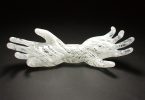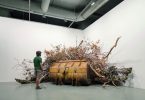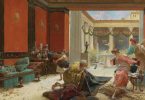Every morning at exactly 9:30, an irresistable urge awakens within me. It feels as though all the moments before it only exist just for that time. Whether I am in a meeting or with a friend, and words are about to spill from my tongue, I realise that the only thing that rolls out instead is ‘coffee!’. The interesting thing is that I am not a person of addictions. In fact, I am quite agreeable in regards to food and beverages. I do have habits like passing through the same streets everyday. However, I can just as quickly change my mind and my route. But that is the thing, every day at exacly 9:30, something happens to me. Most of the time, I find myself in the kitchen with a copper coffee pot, preparing coffee. I meticulously pour some cold water in the coffee pot, putting two coffeespoons of pure coffee over it, and bringing it to a boil on low heat. I slowly mix it. I get the feeling that if my hands don’t do this, then something will be neglected, and the aroma that will soon spread over my tastebuds would be lacking in savor. Coffee is a matter of senses. Perhaps, patience and love. This love becomes much more evident once it is poured into the cup with its froth spreading over the top.
500 years of Turkish Coffee
This is what I felt when I was going to the exhibition ´500 years of Turkish Coffee´ taking place at the Topkapı Palace. Shortly, I was to dive into something that had become an important ritual of my life every morning. However, one´s memory can be sinister. It may also be considered an imaginary roving bird flattering everywhere. And here´s another evocation by that bird. For a long time now, I have had a coffee roasting pan in my library. I wonder if I treat it ill? In fact, it is an antique pan that is so functional in its use. It was a gift from a dear friend of mine and also quite difficult to find. It glimpses at me with its burnt but noble bearing. And what do I do with it? I throw change, shiny things and little items in it. Yet, I am aware just how valuable it is. I know that if I was to pick it up and take it to the kitchen, it would roast me coffee and present me with a festival…
It is possible to hold an exhibition like this in every corner of Istanbul. However, the fact that it is held in the heart of an empire and in a palace that is swamped by visitors from all corners of the world, has a special importance. Perhaps it is also significant as it had the power to unite a sultan and an ordinary person, lifting all boundaries between them and spreading equality amongst all. I bet it is. You can have it if you have a handful of coffee, a little fire and a tiny little cup to drink it from. According to historical texts, coffee too was cursed and banned initially as it was considered a pleasure-inducing drink. However, there was absolutely no boundary and prohibition that was able to hinder that relishing smell. The more it resisted, the more it came to exist.
The Smell of Coffee at the Topkapı Palace
Now it is time to dive into the backstreets of history, as we enter the inner court of the Topkapı Palace and stroll towards the exhibition. Coffee, coffee grinder, coffee roaster, demitasse, coffee maker, coffee seller, coffee beans, coffee mortar, coffee house, coffee pouch, coffee box, coffee brazier, coffee pot, coffee percolator, coffee churn… These words have blossomed beautifully. One bean and a single coffee bean has led to the existence of so many things, actions and states. It is almost as if it has become the womb of a culture. This exhibition clearly illustrates the fact that coffee is not just a beverage but one of the leading features of a culture. Are you curious as to when and how it first surfaced within the Ottoman society? It is right there in the history of Peçevi İbrahim Efendi. The book is open with its pages waiting for you. You can witness the traces of yesterday within every sentence. The letters are all coming to a boil.
Coffee… Coffee…
Green coffee, Nicaragua, East Timor and Peru will slowly nucleate and roll before your eyes. You shall say, it is this little bean that has led to the birth of those graceful mortars, kneading its timber with pleasure aesthetically… These grinders, coffee pouches, coffee boxes, braziers, churns, demitasses and cezve (pots). Alas! The cezve (coffee pot)!… Give yourself some time to think deeply about this interesting design of the human mind. You cannot boil an egg in it. Nor can you heat milk. Its only existence is to froth the coffee and enthuse it. That is why the ‘cezve’ is not just an item but the expression of beauty. We would like to see everything in this life as beautiful as the ‘cezve’. Cezve is also beautiful as a word and poetic in its sound as it tips off our tongues.
Coffee and the Turks
You can also find in this exhibition many books on the story of coffee that has established its own sovereignty both within the palaces and even at the most ordinary dinner tables. These miniature books, which are the visual memory of the Ottoman Empire, also inform us of the kneading of the daily life within history. Under the torrents of the reigns of colour, you are able to watch coffee and the coffee sellers. Every glance at the miniatures, pilgrim drawings, artist drawings and photographs will give you a different perspective. It is almost as though coffee has given colour to the colours and lines.
One of the most interesting attributes of the Ottomans are their understanding of waqfs (charitable foundation). They had established a waqf for coffee just as they had done so for wounded birds. It is not surprising to see this as coffee meant desire, power and the protagonist of the joyful life. As well as being some form of preservation, it was also a passion of sustenance. Mihr-i Vefa Kalfa had made such a donation to the Helvahane (Sweet Store) of the Topkapı Palace and had left behind her love for coffee a legacy. These waqfs, which have a constitutionality, are also a form of clenching this love with the law.
And the fincan (coffee cup)… This word, which has a pronunciation very similar to its equivalent in the Arabic and Persian languages, has attained different forms of pronunciation with the Turks and has become Turkified. The greatest proof of this is the fact that it is likened to beauty within the folk songs, poems and metaphors. So much so that it was not sufficient for coffee to just come to a boil in the pots. They dreamed and thought about how it could be presented in the most beautiful manner.
Today, one of the most universal words must be coffee. It is a word which is quite similar to its one another in almost every language. Tonnes of coffee is consumed every day in China, Russia, Germany and America. It has become one of the main raw materials of global capitalism. At the same time, so many local delicacies, measurements, rituals and habits are in danger. Coffee too, faces the danger of becoming uniform. For this reason, it is also crucial that this exhibition at the Topkapı Palace is held… Perhaps it is a chance to think of the future and not just read about the nostalgia of the past and the story history provides us because coffee, at the same time, means a pleasurable, tasty, aesthetic and authentic life…
TRANSPORTATION
From Atatürk International Airport:
You can take the subway from the Airport to the last stop, Aksaray. You can change at Yusufpaşa Station and get off at the Sultanahmet stop. You can reach the Topkapı Palace Museum by passing along the Ayasofya Museum and Hürrem Sultan Bath.
From Marmaray:
If you take the Marmaray Line, you need to get off at Sirkeci Station. Follow the Cağaloğlu-Vilayet exit and you will come to the Governorship of İstanbul. You can reach the Gülhane Park by taking the road diverting to the left and follow the signs to the Museum thereon.









Leave a Comment